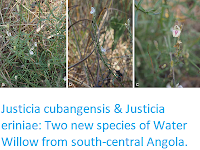The Lecythidaceae are a group of tropical flowering trees and shrubs related to Heathers, which are found across South America, Africa, Madagascar, Asia, Australia and the islands of the Indian and Pacific oceans. Notable members of the group include Brazil Nuts, Bertholletia excelsa, Jequitibá-rosa Trees, and various Asian and Australian Mangroves. The genus Rhaptopetalum currently contains eleven species of Fruiting Trees from Central Africa and one from West Africa.
In a paper published in the journal PhytoKeys on 23 July 2019, David Kenfack of the Forest Global Earth Observatory at the Smithsonian Tropical Research Institute, and the Department of Botany at the National Museum of Natural History, and Diosdado Ekomo Nguema of the Gabon Biodiversity Program at the Smithsonian Conservation Biology Institute, describe a new species of Rhaptopetalum from southwest Gabon.
The new species is named Rhaptopetalum rabiense, meaning 'from Rabi' in reference to the Rabi Forest of southewestern Gabon, where it was discovered. It is a small tree reaching 4-6 m in height, and a maximum of 20 cm at 1.3 m above the ground (waist height), and covered with pale brown bark. The leaves arranged on the stems alternately in two opposite vertical rows, are hairy and lenticular, and can be up to 18 cm in length and 9 cm in width. Pink and yellow flowers are produced on short stems arising from the main branches in August to October. Fruit are green berries 15-20 mm in diameter, produced in September-December.
Rhaptopetalum rabiense (A) flowering branch (B) lateral view of the flower (C) flower view from above showing the poricidal anthers and the gynoecium (D) fruiting branch. Diosdado Nguema in Kenfack & Nguema (2019).
The species was found growing in both flooding and non-flooding parts of the forest, but the total area occupied by the trees was only 0.214 km², and the entire population of 299 trees was contained within an area of 8.00 km². Since this area has no legal protection, and is threatened by both oil and gas production and logging, Kenfack and Ngeuma assess the species to be Critically Endangered under the terms of the International Union for the Conservation of Nature’s Red List of Threatened Species. Importantly the species could not be found in either the Loango National Park to the west or the Moukalaba Doudou National Park on the east.
Rhaptopetalum rabiense (A) flowering twig (B) close-up of the lower surface showing the indumentum and the punctate lamina (C) detail of inflorescence and stem showing lenticels (D) flower bud (E) opened flower (F) flower with pseudocorolla and stamens removed showing superior ovary (G) longitudinal section of (F) showing pendulous ovules (H) fruiting branch. Kenfack & Nguema (2019).
See also...
Follow Sciency Thoughts on Facebook.








